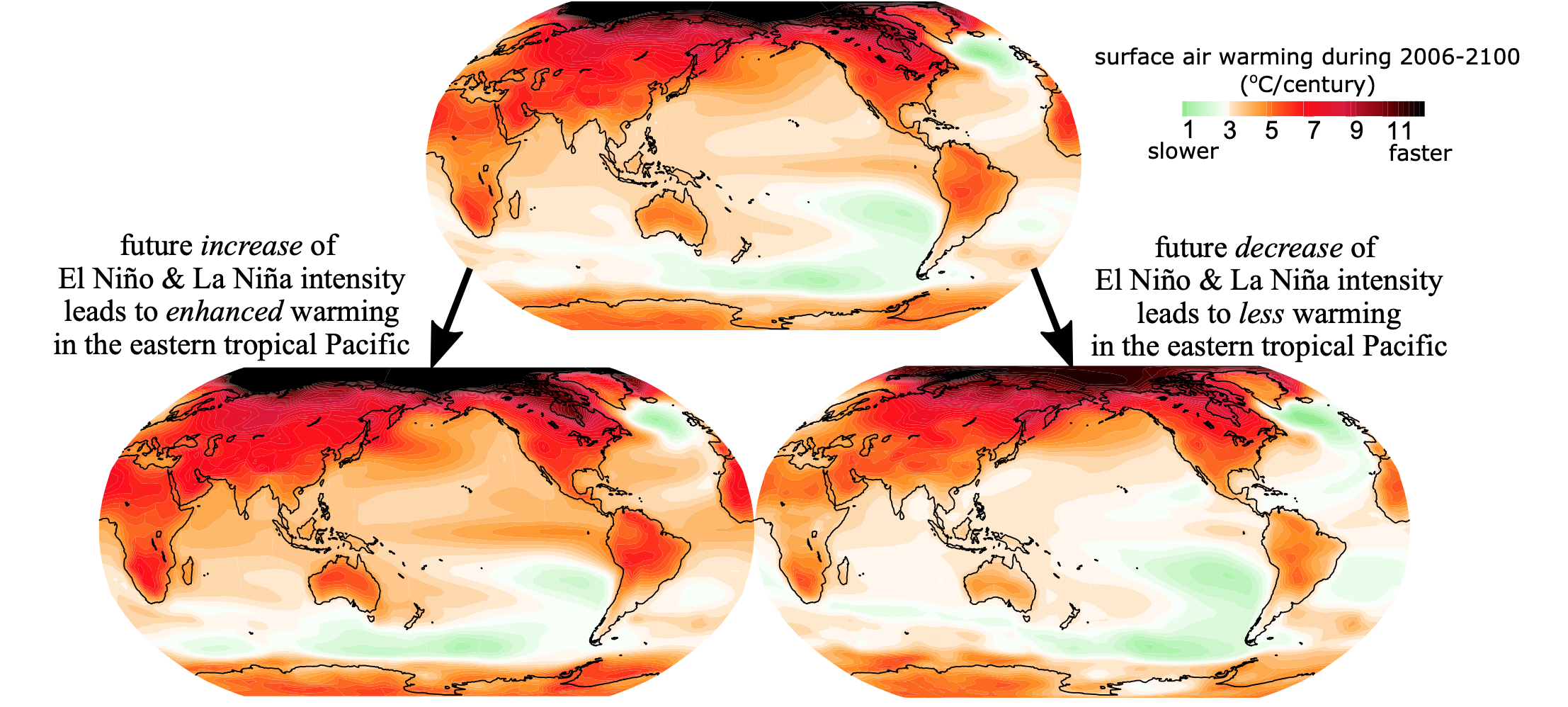Accuracy of El Niño simulation hones climate change estimates
 Future increase of El Nino and La Nina intensity leads to enhances warming in the eastern tropical Pacific (bottom left). Future decrease of El Nino and La Nina intensity leads to less warming in the eastern tropical Pacific (bottom right). Credit: Hayashi et al., 2020.
Future increase of El Nino and La Nina intensity leads to enhances warming in the eastern tropical Pacific (bottom left). Future decrease of El Nino and La Nina intensity leads to less warming in the eastern tropical Pacific (bottom right). Credit: Hayashi et al., 2020.
A new study led by SOEST researchers, published in the journal Nature Communications this week, revealed that correctly simulating ocean current variations hundreds of feet below the ocean surface – the so-called Pacific Equatorial Undercurrent – during El Niño events is key in reducing the uncertainty of predictions of future warming in the eastern tropical Pacific.
Trade winds and the temperatures in the tropical Pacific Ocean experience large changes from year to year due to the El Niño-Southern Oscillation (ENSO), affecting weather patterns across the globe. For instance, if the tropical Pacific is warmer and trade winds are weaker than usual—an El Niño event—flooding in California typically occurs and monsoons in India and East Asia are detrimental to local rice production. In contrast, during a La Niña, the global weather patterns reverse with cooler temperatures and stronger trade winds in the tropical Pacific. These natural climate swings affect ecosystems, fisheries, agriculture, and many other aspects of human society.
Computer models that are used for projecting future climate correctly predict global warming due to increasing greenhouse gas emissions as well as short-term year-to-year natural climate variations associated with El Niño and La Niña.
“There is, however, some model discrepancy on how much the tropical Pacific will warm,” said Malte Stuecker, co-author and assistant professor in the Department of Oceanography and International Pacific Research Center at UH Mānoa School of Ocean and Earth Science and Technology.
Researchers have been working for decades to reduce the persistent model uncertainties in tropical Pacific warming projections.
Many climate models simulate El Niño and La Niña events of similar intensity. In nature, however, the warming associated with El Niño events tends to be stronger than the cooling associated with La Niña. In other words, while in most models El Niño and La Niña are symmetric, they are asymmetric in nature.
In this new study, the scientists analyzed observational data and numerous climate model simulations and found that when the models simulate the subsurface ocean current variations more accurately, the simulated asymmetry between El Niño and La Niña increases—becoming more like what is seen in nature.
“Identifying the models that simulate these processes associated with El Niño and La Niña correctly in the current climate can help us reduce the uncertainty of future climate projections,” said corresponding lead author Michiya Hayashi, a research associate at the National Institute for Environmental Studies, Japan, and a former postdoctoral researcher at UH Mānoa supported by the Japan Society for the Promotion of Science (JSPS) Overseas Research Fellowships. “Only one-third of all climate models can reproduce the strength of the subsurface current and associated ocean temperature variations realistically.”
“Correctly simulating El Niño and La Niña is crucial for projecting climate change in the tropics and beyond. More research needs to be conducted to reduce the biases in the interactions between wind and ocean so that climate models can generate El Niño – La Niña asymmetry realistically,” added Fei-Fei Jin, co-author and professor in the Department of Atmospheric Sciences at UH Mānoa.
“The high uncertainty in the intensity change of El Niño and La Niña in response to greenhouse warming is another remaining issue,” said Stuecker. “A better understanding of Earth’s natural climate swings such as El Niño and La Niña will result in reducing uncertainty in future climate change in the tropics and beyond.”
Read also on Science Daily, Phys.org and UH News.




